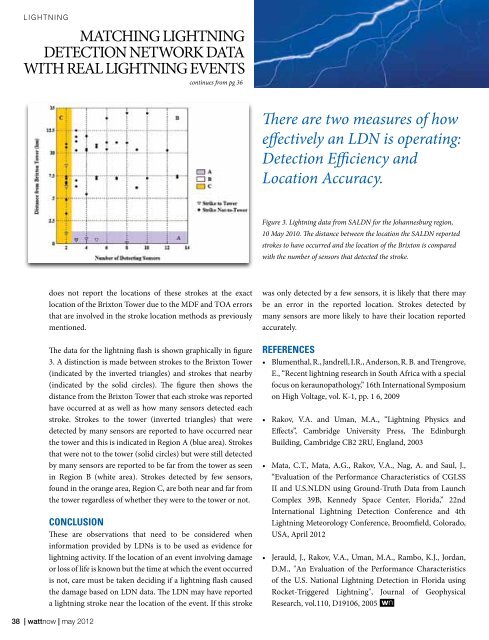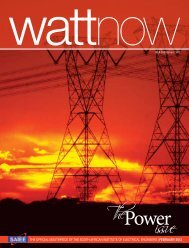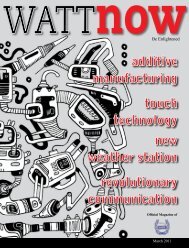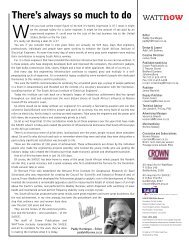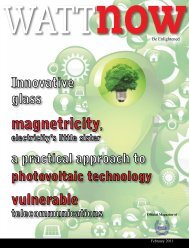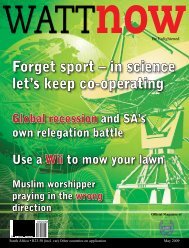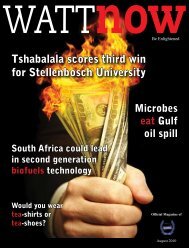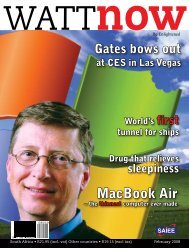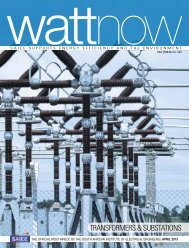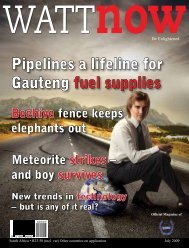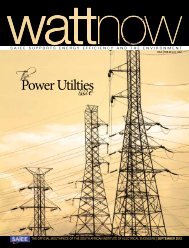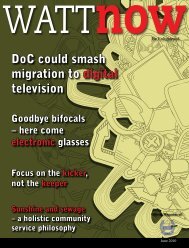download a PDF of the full May 2012 - Watt Now Magazine
download a PDF of the full May 2012 - Watt Now Magazine
download a PDF of the full May 2012 - Watt Now Magazine
Create successful ePaper yourself
Turn your PDF publications into a flip-book with our unique Google optimized e-Paper software.
LiGhtninG<br />
does not report <strong>the</strong> locations <strong>of</strong> <strong>the</strong>se strokes at <strong>the</strong> exact<br />
location <strong>of</strong> <strong>the</strong> Brixton Tower due to <strong>the</strong> MDF and TOA errors<br />
that are involved in <strong>the</strong> stroke location methods as previously<br />
mentioned.<br />
The data for <strong>the</strong> lightning flash is shown graphically in figure<br />
3. A distinction is made between strokes to <strong>the</strong> Brixton Tower<br />
(indicated by <strong>the</strong> inverted triangles) and strokes that nearby<br />
(indicated by <strong>the</strong> solid circles). The figure <strong>the</strong>n shows <strong>the</strong><br />
distance from <strong>the</strong> Brixton Tower that each stroke was reported<br />
have occurred at as well as how many sensors detected each<br />
stroke. Strokes to <strong>the</strong> tower (inverted triangles) that were<br />
detected by many sensors are reported to have occurred near<br />
<strong>the</strong> tower and this is indicated in Region A (blue area). Strokes<br />
that were not to <strong>the</strong> tower (solid circles) but were still detected<br />
by many sensors are reported to be far from <strong>the</strong> tower as seen<br />
in Region B (white area). Strokes detected by few sensors,<br />
found in <strong>the</strong> orange area, Region C, are both near and far from<br />
<strong>the</strong> tower regardless <strong>of</strong> whe<strong>the</strong>r <strong>the</strong>y were to <strong>the</strong> tower or not.<br />
conclusion<br />
These are observations that need to be considered when<br />
information provided by LDNs is to be used as evidence for<br />
lightning activity. If <strong>the</strong> location <strong>of</strong> an event involving damage<br />
or loss <strong>of</strong> life is known but <strong>the</strong> time at which <strong>the</strong> event occurred<br />
is not, care must be taken deciding if a lightning flash caused<br />
<strong>the</strong> damage based on LDN data. The LDN may have reported<br />
a lightning stroke near <strong>the</strong> location <strong>of</strong> <strong>the</strong> event. If this stroke<br />
38 | wattnow | may <strong>2012</strong><br />
continues from pg 36<br />
There are two measures <strong>of</strong> how<br />
effectively an LDN is operating:<br />
Detection Efficiency and<br />
Location Accuracy.<br />
Figure 3. Lightning data from SALDN for <strong>the</strong> Johannesburg region,<br />
10 <strong>May</strong> 2010. The distance between <strong>the</strong> location <strong>the</strong> SALDN reported<br />
strokes to have occurred and <strong>the</strong> location <strong>of</strong> <strong>the</strong> Brixton is compared<br />
with <strong>the</strong> number <strong>of</strong> sensors that detected <strong>the</strong> stroke.<br />
was only detected by a few sensors, it is likely that <strong>the</strong>re may<br />
be an error in <strong>the</strong> reported location. Strokes detected by<br />
many sensors are more likely to have <strong>the</strong>ir location reported<br />
accurately.<br />
references<br />
• Blumenthal,R.,Jandrell,I.R.,Anderson,R.B. andTrengrove,<br />
E., “Recent lightning research in South Africa with a special<br />
focus on keraunopathology,” 16th International Symposium<br />
on High Voltage, vol. K-1, pp. 1 6, 2009<br />
• Rakov, V.A. and Uman, M.A., “Lightning Physics and<br />
Effects”, Cambridge University Press, The Edinburgh<br />
Building, Cambridge CB2 2RU, England, 2003<br />
• Mata, C.T., Mata, A.G., Rakov, V.A., Nag, A. and Saul, J.,<br />
“Evaluation <strong>of</strong> <strong>the</strong> Performance Characteristics <strong>of</strong> CGLSS<br />
II and U.S.NLDN using Ground-Truth Data from Launch<br />
Complex 39B, Kennedy Space Center, Florida,” 22nd<br />
International Lightning Detection Conference and 4th<br />
Lightning Meteorology Conference, Broomfield, Colorado,<br />
USA, April <strong>2012</strong><br />
• Jerauld, J., Rakov, V.A., Uman, M.A., Rambo, K.J., Jordan,<br />
D.M., "An Evaluation <strong>of</strong> <strong>the</strong> Performance Characteristics<br />
<strong>of</strong> <strong>the</strong> U.S. National Lightning Detection in Florida using<br />
Rocket-Triggered Lightning", Journal <strong>of</strong> Geophysical<br />
Research, vol.110, D19106, 2005


